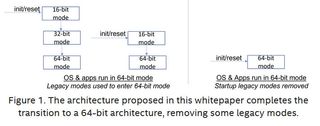
Legacy pruning of the architecture is outlined in a new Intel whitepaper.
When you purchase through links on our site, we may earn an affiliate commission. Here’s how it works.

Intel has published a new whitepaper (PDF) that envisions simplifying its processor instruction set architecture (ISA). The main thrust of the proposed move would be to pare back the extensive legacy support and go 64-bit only with a new and simplified 'Intel x86S' architecture. Several technical benefits are outlined in an Intel developer blog post. In summary, the legacy reduced x86S architecture removes outdated execution modes to benefit upcoming hardware, firmware, and software implementations.
Many contemporary PC users who enjoy using the latest Windows applications and games will have moved to 64-bit Windows during the Windows 7 era. This coincides with the time when system RAM amounts above 4 GB became commonplace (a 32-bit OS can only address 3.2 GB of RAM), and 64-bit applications and games started to become mainstream. So, with the current Windows 11 OS being 64-bit only and apps and games sucking up gigabytes of RAM, it seems reasonable for Intel to want to consign architectural considerations spanning all the way back to the original 8086 chip to history.
"Intel 64 architecture designs come out of reset in the same state as the original 8086 and require a series of code transitions to enter 64-bit mode," Intel explains with regard to its legacy support. "Once running, these modes are not used in modern applications or operating systems."

So, it is easy to understand there will be benefits from architectural pruning, and the complex booting process outlined above would be the first benefit observed by users of new Intel x86S chips. What are other benefits to users and developers? Intel provides the following bullet points:
For those interested in running older OSes and software on the latest Intel hardware, Intel suggests that there are mature virtualization-based software solutions and that users can employ virtualization hardware (VMX) "to deliver a solution to emulate features required to boot legacy operating systems." Ardent retro computing fans will also collect and use old PC systems for running their ancient software libraries. Earlier this week, we noted that there are new Intel 386 and Intel 8088 portables being developed and sold online.
Those who think that they will be impacted by the proposed Intel 64-bit only x86S architecture transition should take a closer look at the linked whitepaper, which Intel appears to have published to gauge user/developer reaction and potentially gather feedback.
Get Tom's Hardware's best news and in-depth reviews, straight to your inbox.
By submitting your information you agree to the Terms & Conditions and Privacy Policy and are aged 16 or over.